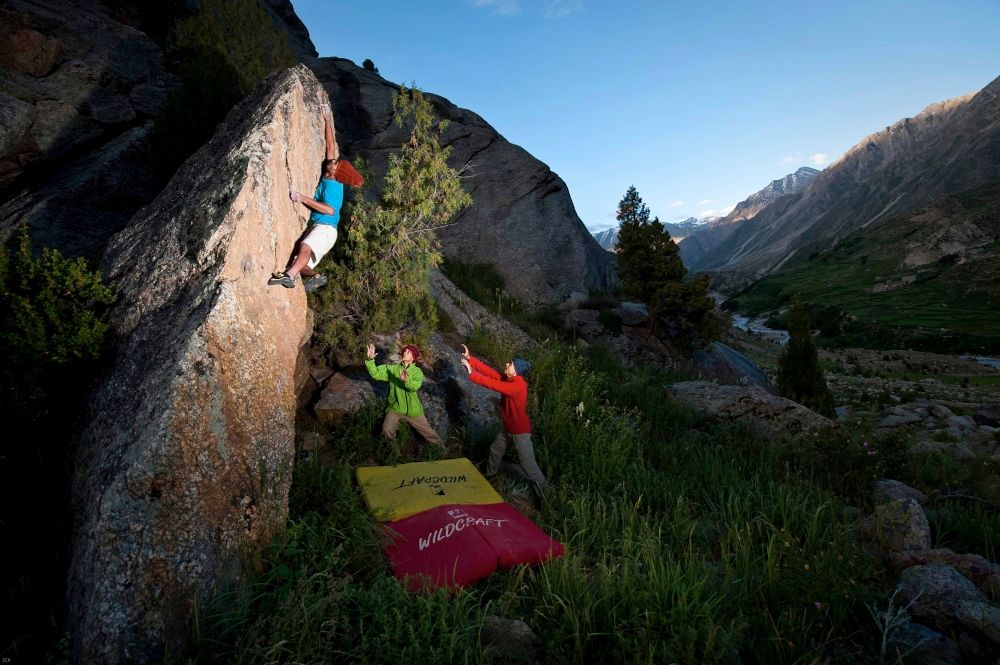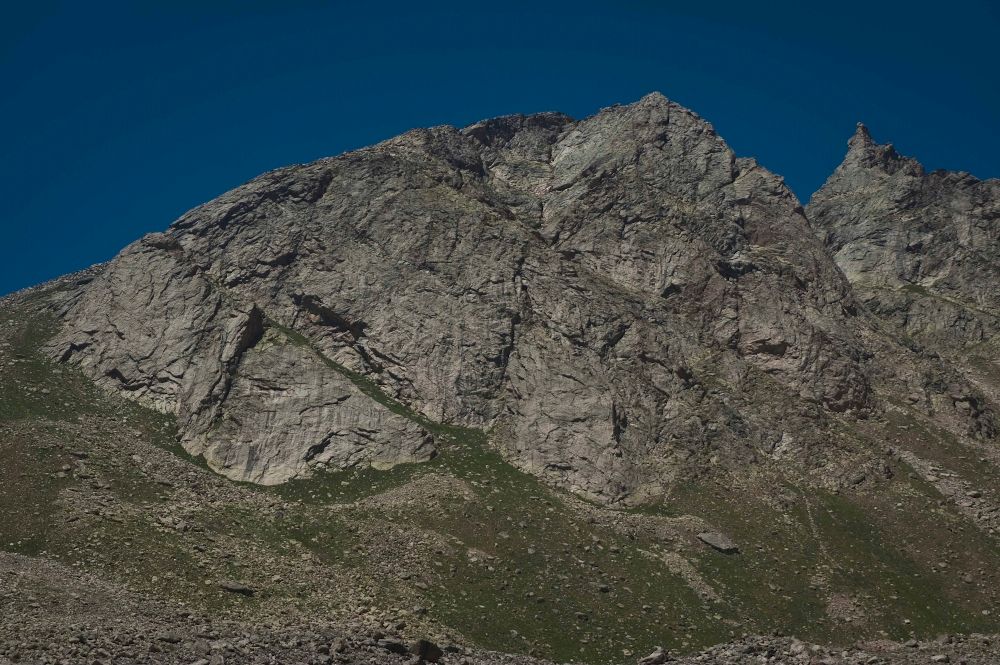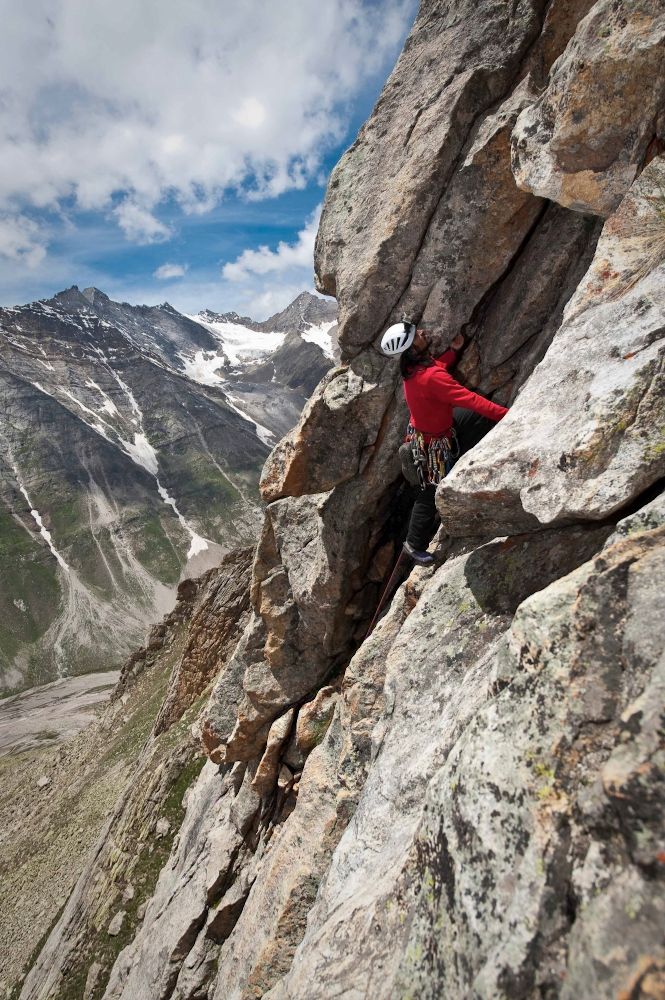Piolets d'Or Announces the "Significant Ascents" of 2023
This list of 68 climbs is effectively a "long list" used to select nominees of the prestigious alpine award.

Seen from the outside, we must have cut a funny picture.
A bunch of sunburnt faces clustered around a window gazing intently, curiously. We had had our share of climbing. It was time to climb vicariously. The year was 2004, the place, Delhi.
The man on the climbing wall outside moved confidently, gracefully. He had initially traversed the lower routes; then climbed up, alone. All of us, members of Girivihar, a Mumbai based-mountaineering club, returning from a climbing expedition in the Zanskar Himalaya, watched him from the dormitory of the Indian Mountaineering Foundation (IMF). Abhijit Burman (aka Bong), left the room to investigate.
He soon appeared near the wall, stalking his quarry as Bong typically did, eventually managing a conversation and a handshake. We did our due share of bantering and passing comments; we had known Bong and his ways for long. A while later, Bong returned excited. ``Arre, shake my hand! That is Thomas Huber, they have come to attempt Arwa Spire,’’ he said.
Arwa Spire, Arwa Tower and Arwa Crest are snow capped peaks in the Himalaya characterised by huge vertical rock faces. Thomas was one half of Germany’s Huber brothers, famous for their ascent of big rock walls. We learnt later that they successfully climbed the west peak (6088m) of Arwa Spire.
My climbing skills have at best been, modest. Those days, it was distinctly modest within modest. I was a plankton, the club members around were fish, the Huber brothers were whales. I remember doing my share of peeking out from the dormitory environs to get a better look of Thomas Huber, whose climber-hands Bong had just shaken. Shaking hands with Bong, who had shaken hands with Thomas Huber, seemed to all of us, like transference of DNA. That was the amusing half of the incident. The more serious half was that – as indeed everyone knows – long and vertical defined climbing, and the Huber brothers were in the thick of it. In all that sweating for glory (that isn’t how I like it but it is how climbing ends up as in the eyes of the beholder), there is only so much you can glorify sport climbing and bouldering. Big wall is the closest rock climbing gets to the scale of mountaineering.
Girivihar is Mumbai’s oldest mountaineering club. In 2004 (as well as now in 2015), the club’s glory days were behind it. It had done pioneering climbs in the Western Ghats and the Himalaya and then lapsed into a comparative lull. It was partly due to the changed times with few possessing the freedom to go on extended trips; it was also partly a case of different human beings, I suspect. We were soft folks, I think. Today’s majority is doing a little and then milking the most out of it using media. But thanks to media, we were also climbing’s well informed couch potatoes – we knew about big wall climbing and the Huber brothers. We knew the deficiency gap between us and the images we saw in climbing magazines. And I suppose, all adventure begins in thoughts of whether we can bridge such gaps.
Four years or so after that chance encounter with Thomas Huber in Delhi, the club decided to attempt the East Face of Kedar Dome (6830m) in Garhwal. To the best of Girivihar’s knowledge, there had been no officially approved Indian civilian expedition to attempt big walls in the Himalaya. When I spoke to him for writing this article, Bong attributed the move to an attempted convergence of the club’s experience in the Himalaya and the ascent of a new generation of rock climbers in Mumbai. I associate this new generation with a single name - `Finger Crisis.’
Years ago, when I first attempted this climbing route in Mumbai, my crisis-stung fingers couldn’t help agreeing with the brilliance of that name. Finger Crisis and routes nearby was where you met Vaibhav Mehta. Vaibhav and his friends – Sandeep, Shyam, Mangesh, Neerav, Jay and more – represented a new wave in the city’s climbing circuit. They were dedicated, powerful climbers, prone to spending hours at the crag. They took the sport’s centre of gravity away from trad climbing and pinnacle-ascents to sport climbing and bouldering. Within a few years, the new trends overshadowed the old, at least for those addicted to climbing. It was much needed change too for Mumbai is a city with tendency to stagnate in the old. Bong thought Girivihar would be able to do a big wall expedition with this new crop of climbers.
However, more than climbing, the project would prove an expedition in learning. Girivihar’s challenges were basic.
Kedar Dome’s East Face involves mixed climbing. To begin with, there were few people in Mumbai who combined good skills on rock and ice. The mountaineering lot were given to the Indian tradition of large expeditions with hired helps. Alpine style ascents featuring lean teams were a rarity.
Many of these mountaineers were average climbers on rock. They weren’t fiercely the Himalayan type either for mountaineering is resource-heavy; in the typical Indian environment, spending a month every year in the Himalaya is a costly luxury. And if you don’t frequent the Himalaya, you won’t be at home there. On the other hand, the best rock climbers had become Sahyadri (the hills of the Indian peninsula, called in total as the Western Ghats) crag rats, never venturing into unfamiliar terrain. They had become specialized for their warm weather, climbing-ecosystem. They had no appetite for the punishment that high altitude and big, cold mountains posed.

The club assembled a team largely composed of young rock climbers with a few mountaineers thrown in. At practice sessions in Pune and at Ramnagaram near Bangalore they understood how far off the mark they were in terms of teamwork and a work ethic suited to high altitude. Luckily, that sense of awareness prevailed. Within months, the more experienced climbers agreed to call off the expedition.
``That first attempt was poorly imagined and planned. We had neither done proper homework nor understood what a big wall at altitude entailed,’’ Vaibhav who was to lead the climbers on the wall, said. Following the trip’s cancellation, Bong and Franco Linhares, who was the club president then, travelled north to check out the targeted rock face so far studied only from Internet photos and expedition reports by foreign teams who had climbed it. In Garhwal, looking at Kedar Dome’s giant East Face, Franco was convinced of the enormity of the challenge. ``It was serious stuff,’’ he said. As a club member, I was disappointed when the expedition was called off. Not so much for big wall lost as for an opportunity to attempt Kedar Dome in the regular mountaineering fashion. The way this trip was originally conceived, there would have been two teams on the mountain. I was to be in the much smaller team attempting a conventional ascent.
Notwithstanding cancelled expedition, the big wall project didn’t die. It hibernated. That’s Girivihar’s strength.
In 2004 when we climbed that peak in Zanskar, it was after three expeditions to the region ranging from exploratory to path finding to actual summit attempt.
Two years after calling off the Kedar Dome trip, Girivihar organized a big wall expedition in the Miyar Nala area of Himachal Pradesh. This too was based on foreign reports but the approach to the project was more realistic. Vaibhav was by then working and living at Leh in Ladakh, where he ran a climbing gym. With him moving that side, a couple of close friends, also climbers from Mumbai, had shifted there.
One of them was Shyam Sanap, a strong moody climber, particularly good at bouldering. They consistently climbed in and around Leh. This – climbing at altitude (Ladakh is above 10,000ft) – fitted in with the required approach to attempting a big wall project at altitude. But problems continued. Typically big wall expeditions in the Himalaya – indeed any expedition - by foreign teams are lengthy affairs because acclimatization is a must to perform well. In the case of Indian expeditions, most people are on leave from city based-jobs they can’t afford to lose. So the duration of an expedition is normally just a month. It means that those coming from the plains are not going to be climbing at maximum strength in Miyar Nala even if they left Mumbai’s sea level-altitude in peak form. Second, the shortage of climbing equipment lingered. The group had no multiple sets of protection devices yet. The club’s cachet of equipment, collected and preserved over the years was there. But it seemed insufficient.

On arrival at location, the team shifted the target from an earlier planned vertical big wall to a more inclined, long stretch of slab. Rock in slab form with gentler incline is a better, more forgiving medium to get used to challenges. It was blunt experiential education happening. In the Himalaya and seeing that vertical face alongside available climbing calibre and gear, the team realized they were unprepared for a combination of long climb and absolute verticality. The shift to the slab made sense.
While the slab project was on, it rained.
Enter the third problem – bad weather. People from warm peninsular India are no stranger to the rains. Among Indian metros, Mumbai has one of the heaviest monsoon seasons. But how the rains feel, the way it changes the overall ambience – that takes a toll depending on where you are. Up in the Himalaya, rain meant wetness and cold. Clouds descended, visibility would turn poor. What was joyous mood of expansive mountains till some minutes ago became world shrunk to a few square metres of cold, damp existence. Very often in such situations, teams have to wind up work and wait out the bad weather. The Himalaya is an epic you tackle patiently.
I asked Mangesh Takarkhede, a seasoned sport climber and part of the second expedition what was the toughest difference between the Sahyadri and the Himalaya that he endured at Miyar Nala. ``Sitting in a tent doing nothing while the weather ran amok outside,’’ he said. Mountaineers and high altitude trekkers learn this from years of being out. Nature is not in your hands and you have to learn to be patient, last things out, sometimes work despite it. But urban climbing, even sport climbing (which is climbing on pre-designed, pre-set routes and is the style that hosts climbing competitions), is a different animal. It is young, impatient and increasingly in a self endorsing cocoon narrowly focused on climbing to the expense of all else. Bad weather and the unpredictability of mountain terrain aren’t a problem in the controlled conditions of a climbing gym – are they?
Vaibhav himself admitted that he would rather climb than hike although hiking is the only way man ever properly understood any terrestrial environment. In the limited window of opportunity available, the team nevertheless ascended several pitches (rope-lengths) up the chosen rock slab, some getting their first taste of Himalayan rock and rock climbing at altitude. According to the club’s in-house report, `` In this first exploratory trip, The team succeeded in climbing a 1100m long virgin rock face, with climbing grade of about 5A and total of 23 pitches. The two team members who summitted were Vaibhav Mehta and Shyam Sanap, while others climbed a 600m route on the same face.’’

In 2012, a third big wall expedition was mounted. This time the objective was Miyar Nala’s Toro Peak, already climbed by a foreign climber who had left behind route details. Weather was good. The team climbed Toro Peak two times that month. It showed their growing comfort with the environment. The club’s report said, ``We succeeded in a pure rock climbing ascent of Toro Peak (4860mts)’’ They opened two new routes, one being a central route of 550m; the other, a South Eastern ridge of 400m. Two separate climbing teams, one of three climbers and the other, of two climbers, topped. The climbing grades appeared easy overall save for the final portions. The report indicated a long day (over 12 hours) from base camp to summit and back. To be factored in additionally would be the effect of altitude on human effort. All in all, it was a more encouraging outcome than happened on the previous trip.
However problems persisted. Given ancient volcanic rock that broke off periodically, many routes in the Sahyadri had shifted to being bolted; diluting to that extent the climber’s ownership of protection placed. It freed him to climb but removed a critical component of true climbing from the frame, which is - you are responsible for your safety and should therefore know how to place protection.
For the few still doing traditional climbing (trad) this way in the Sahyadri, Himalayan rock (nature of rock influences equipment placement style) was new. Result – the required trad climbing competence wasn’t second nature yet for the team. In contrast, years ago, Girivihar had pioneered civilian mountaineering from Mumbai, including the first civilian expedition to the Himalaya from the state of Maharashtra and the first Indian civilian attempt to scale an 8000m peak, Mt Kanchenjunga. In the Sahyadri, it had trekked hard and climbed pinnacles. It had a past that was rich in Himalayan experience and trad climbing in the Sahyadri. Now it celebrated sport climbing and was identified best with an annual sport climbing competition on artificial climbing walls. Perhaps the unnoticed drift here had been acclimatizing to staged-events?

Psychologically, this was a shift from the typical Himalayan environment and the whole deal of being outdoors. What Mangesh said had more to it than met the eye. An observation by Vaibhav also struck similar note. According to him, unlike in the Sahyadri, where rain is seasonal and spring and winter have nice dry days, a variety of factors affect the climber’s window in the Himalaya. When the weather is apt, you have to use it well. The climber has to be efficient; something particularly important on big walls where rope and gear can be many. Vaibhav felt that climbers from the smaller, sunny Sahyadri hills, while certainly good on rock, have slipped into a comfort zone (he didn’t spare himself). It is a bit like Sahyadri all the time, everywhere, when all the time and everywhere isn’t Sahyadri. The biggest handicap born from comfort zone is ego. It blocks change. Arguments erupted at altitude among the participants during the second Miyar Nala trip causing fissures in the team. That’s how much a change to familiar context can mean. Equally, that’s how much an attempt to do something new can teach.
After three expeditions and Toro Peak done, Vaibhav believed there was a lot to learn before the team could be on a genuine big wall. He was yet to trad-climb in the Himalaya with the same top notch calibre that he was capable of at lower altitudes in peninsular India. He wanted that flow. ``I wish to climb hard on rock, at altitude,’’ he said in the Navi Mumbai suburb of Belapur, where preparations were on early January 2013 for the 10th edition of Girivihar’s annual climbing competition featuring sport climbers from home and overseas.
This is the story till then of the first Indian civilian attempt to climb a big wall in the Himalaya. What they did does not match the visual impact of typical big wall-imagery from overseas or even such imagery from the rock faces of peninsular India, an environment they are used to. But they looked in the big wall mirror of the Himalaya and saw themselves. They know where they stand. Knowing them, the team should be back for more. Vaibhav felt that a big wall expedition in the Himalaya could be candidate to collaborate with foreigners who had done it before. ``You learn a lot,’’ he said.
Perhaps that gentleman, from a morning long ago at the IMF climbing wall, should hear this.
images©Sharad Chandra
read more blogs from the author on https://shyamgopan.wordpress.
[gallery type="rectangular" ids="3149,3147,3146,3145,3144,3143,3142,3132,3131,3136,3129,3150,3121,3148"]
2nd best newsletter in the universe